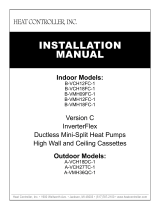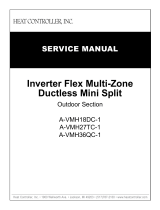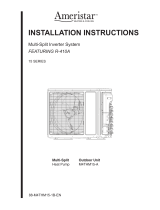
Installation and Operation Manual - VMH 09/12/18/24 SU Series
Electrical Work
Outdoor unit power and
communication cable wiring
1. Remove the electrical control cover from the
outdoor unit (Fig. 24).
2. Connect power supply wires to the right side of
the outdoor unit’s terminal strip. (Fig. 25)
3. Connect the green/yellow ground from the power
supply wire to ground terminal. (Fig. 25)
4. Connect the communication cable from the
indoor unit to the outdoor unit’s terminal strip on
the left side. (Fig. 25)
5. Connect the ground wire of the communication
cable to the ground terminal. (Fig. 25)
6. To prevent water from entering the unit, form a
loop in the cable (Fig. 26).
7. Insulate any unused conductors with electrical
tape, so that they do not touch any other
exposed electrical or metal parts.
Fig. 24
Fig. 26
Air inlet(side)
Air outlet
Screw
Cover
Loop the cable
Air inlet(rear)
Fig. 25
OR
To indoor unit To power supply
To indoor unit To power supply
Terminal block of outdoor unit
Conduit panel
Connecting cable
Power supply cord
To power supply
Cover control
Over 1 3/4in. (40mm)
Outdoor Unit
Fig. 27
VMH 09/12/18/24 SU/30 SD Inverter Mini-Split
Initial Start-Up & Checks
Operation of the unit will depend on the setting of
the thermostat on the unit or the remote control.
Refer to the owner’s manual and remote control
manual for operating instructions.
IMPORTANT!
All panels must be installed, main power turned on
and the wiring, refrigerant lines, and condensate
drain lines properly connected before operating the
unit.
Test-Run / Initial Start-up
1. Press the ON/OFF button on the remote control
to turn the unit on.
2. Press the mode button on the remote control to
check that each mode (Cool, Heat*, Auto, Dry
and Fan only) works properly.
3. When the ambient temperature is too low (below
62°F/16°C) to run the unit in cooling mode to
check the system, the unit can be placed in
manual operation.
4. To place the unit in manual operation, gently lift
up the lower left and right sides of the front panel
until it opens and clicks into a locked position
where it props itself open.
5. Under the unit’s front panel the cover to the
indoor electrical terminal strip has an oval
shaped opening labeled “AUTO/COOL”. Through
this opening, the “AUTO/COOL” button can be
accessed with a long, thin object, such as a pen/
flathead screwdriver.
6. Press the “AUTO/COOL” button and manual
operation will begin.
7. Manual operation will allow the unit to run for 30
minutes while any final inspections are made.
FINAL INSPECTION
Do a nal visual inspection of the entire installation.
Complete any nal details and clean up.
Review Unit and Remote Control Operation with
the homeowner/user.
Ensure homeowner/user is provided with all
manuals, warranty cards, etc.
FIELd CHARgINg
Unit performance, efciency, and life depends,
to a large extent, on a proper system charge.
Time spent getting the charge right at start-up will
payoff in the long run. Operating conditions such
as voltage, air flow, evaporator coil size, and
indoor and outdoor temperature and humidity all
have an effect on the system pressures and
superheat conditions.
Condensing units are factory charged for the
outdoor and indoor unit with 25ft. (7.6m) of
refrigerant lines. Charge must be added for the
interconnecting tubing.
These units should be critically charged to ensure
proper performance. Some systems may require
additional charging of refrigerant, depending on
line set lengths.
R = T X (L-25)ft
R(oz): Additional refrigerant to be charged
L(ft): The length of the refrigerant line
T(oz): The quantity of the charged refrigerant
per additional foot.
Model
09, 12, 18 24
oz/ft 0.16 0.32
Conduit panel
Connecting cable
Fig. 27
o AUTO/COOL
Manual control button
VMH 09/12/18/24 SU/30 SD Inverter Mini-Split
15






















